Origins of the Palace of Caserta 1742-1747
In the year 1734, in the context of the War of the Polish Succession, Carlos de Borbón, third son of Felipe V and his second wife, Isabel Farnesio, conquered the kingdoms of Naples and Sicily, which had been under Austrian rule since the War of Spanish Succession. However, the Treaty of Vienna (1738) stipulated that Naples and Sicily should form a single independent state that could not be under the sovereignty of the Crown of Spain.
Throughout his reign, and especially from 1746, Carlos de Borbón undertook numerous political, cultural and social transformations for the modernization of the kingdom, reforming the obsolete administration of its territories and removing power from the nobility and the Church to centralize it in the crown.
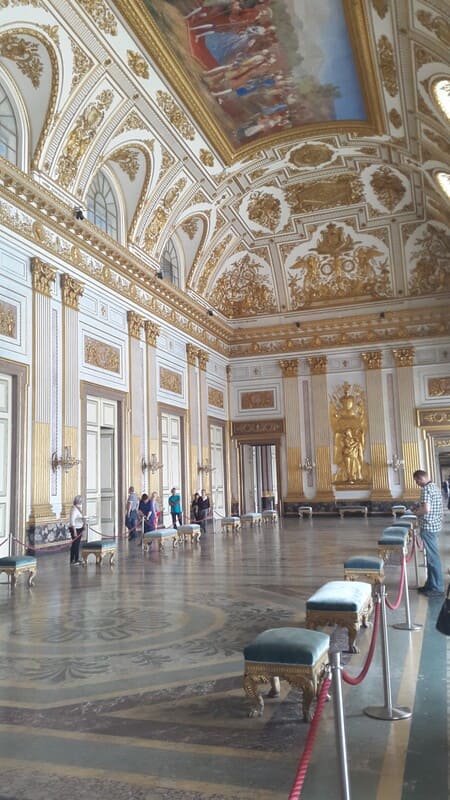
Creation of the Royal residence
One of his main projects was the creation of a royal residence that would serve as the court and government headquarters of the new kingdom, following the example of the Palace of Versailles in France. The ambitious project was first considered in August 1742, after the English fleet had threatened Naples during the War of the Austrian Succession. It would not arise again until 1747, the year in which the birth of Prince Felipe Antonio de Borbón guaranteed the consolidation and continuity of the dynasty.
Site of the Palace of Caserta
The site chosen was the plain of Caserta north of Naples, owned by Michelangelo Gaetani d’Aragona, Count of Caserta, which was purchased in 1750 for 489,343 ducats. While the new palace was being built, the royal family settled in the old residence of the Gaetani, the Palazzo Vecchio, which for 30 years (from 1750 to 1780) was the seat of the court during the winter months, from January to Easter, when the court returned to Naples.
The project of the Royal Palace of Caserta – 1747-1751
The king’s project was not limited to the construction of a palace, but to create a new city that would have all the urban developments of the time and be the most advanced capital in all of Europe. Many names of architects were considered to receive the unique commission, such as Ferdinando Fuga or Nicola Salvi, although the decision was finally made to hire the Neapolitan architect Luigi Vanvitelli.
The architect Luigi Vanvitelli
Vanvitelli was protected by Popes Clement XII and Benedict XIV, for whom he worked intensely in the Ancona region, then, under the latter’s orders, he worked in Rome preparing the jubilee of 1750. King Charles paid a visit to the United States Pontifical, in order to ask the pope for permission to hire his protégé, an objective that he finally achieved. In 1751, Vanvitelli presented his project to don Carlos, who was pleasantly satisfied with it. Vanvitelli’s disciples would also participate in it, including Francesco Sabatini, who would later also undertake projects in Madrid.
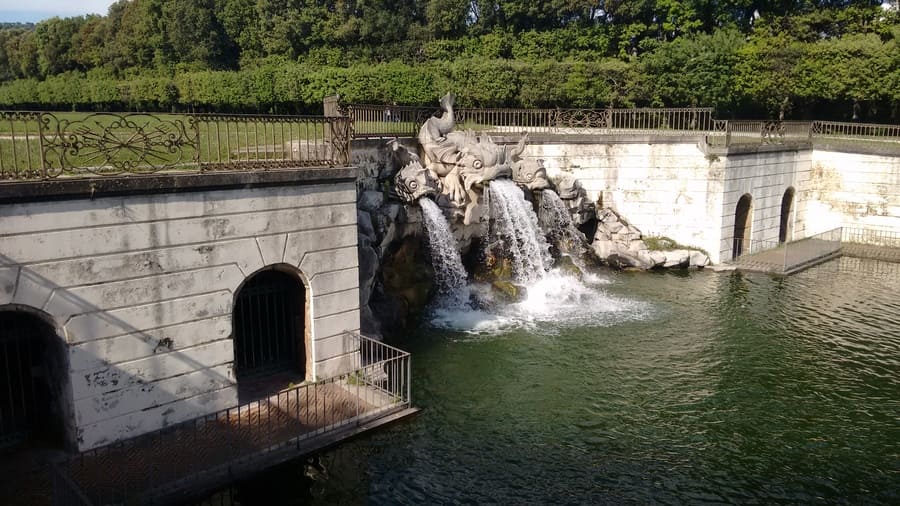
The dimensions of the Royal Palace of Caserta
The planned palace was a huge building, rectangular in shape, with an area of 47,000 square metres, 1,200 rooms and five floors (ground floor, mezzanine, two piano nobiles and an attic). The first two floors would present a rusticated finish typical of palatial architecture, while the piano nobile would be highlighted with colossal columns on three projections, one central and two at the ends. In this way, the interior structure and organization could be observed from the outside. The interior space would be made up of a central pavilion from which four wings would start, creating four interior patios.
The city around the Palace
Around the palace a city was erected following the Versailles model: a large oval square would serve as the cour d’honneur of the palace and as an articulating element of the city, while behind it would extend a garden with parterres that would culminate in a perspective composed of large waterfalls . Plaza and garden would be visually connected through a “great porch” that would run through the ground floor of the palace, as a scenic perspective that would also meet the ceremonial requirements. Vanvitelli knew how to achieve the king’s goal, to emulate his two favorite palaces: Versailles and La Granja de San Ildefonso.
In 1756, to publicize his project, Vanvitelli would publish a collection of engravings with plans, elevations and detailed explanations called Dichiarazione dei disegno del reale palazzo di Caserta. The publication constitutes a fundamental work to discover the ambitious ideas of the architect, many of which would never come to fruition.
Construction begins (1752-1759)
It was on January 20, 1752, coinciding with the anniversary of the king’s birth, that the first stone of the Caserta Palace was laid. center, a pavilion of crimson velvet was erected where King Carlos, Queen Maria Amalia, Prime Minister Tanucci and Apostolic Nuncio Luigi Gualterio, as well as other members of the royal family, knights and gentlemen of the court and ministers and foreign ambassadors. After the nuncio’s blessing, the first stone was buried, inside which several gold medallions with laudatory inscriptions had been placed.
The Foundation stone of the Palace of Caserta is laid
The king had projected that the entire Caserta complex would be completed in ten years, so the work progressed rapidly thanks to great financial support: each year the works received half a million ducats, out of a total budget estimated at 5 million ducats. , which was soon considered insufficient.
However, in 1759, the king had to leave for Spain to occupy the throne after the death of his brother Fernando VI, which meant a stagnation in the works of the palace. On the one hand, the new monarch Fernando IV was only eight years old; on the other, the new manager Tanucci did not feel great interest in the project, reducing the workforce by half
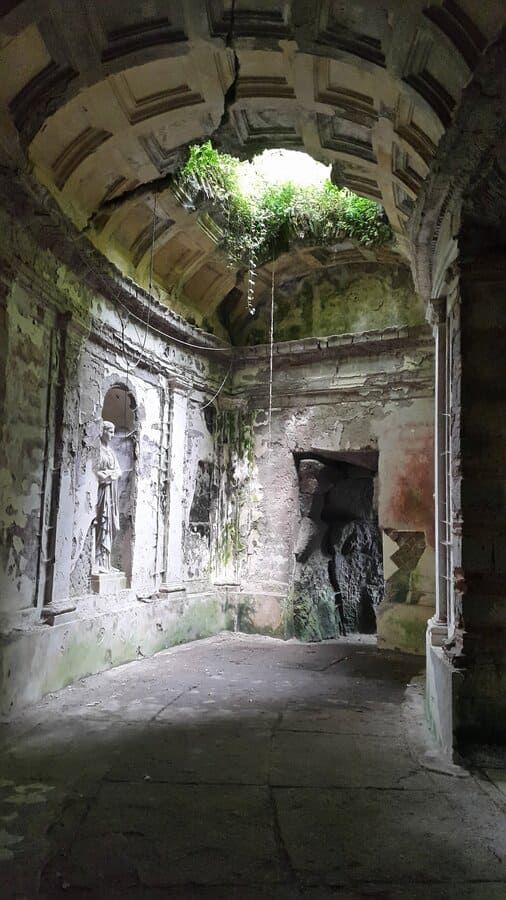
The recovery of the works (1759-1780)
Vanvitelli himself lamented the departure of King Carlos and the stagnation of the project. Despite everything, the architect remained excited about the construction of the palace. In 1766, although the works were not finished, Ferdinando Galiani was ecstatic at the beauty of the construction, judging it even more beautiful than Versailles.
The Vesuvius drives the Works of the Palace of Caserta
A year later, following the coming of age of Ferdinand IV and the eruption of Vesuvius that had threatened the royal palace of Portici, the works in Caserta took on a new impetus, with an increase in the budget for the works and the template. Two years later, during the carnival of 1769, Ferdinand IV and his new wife Maria Carolina of Austria inaugurated the first interior of the palace to be completed, the Court Theater.16 It was the only space that Vanvitelli saw completed, which He died in 1773 and left his son Carlo in charge of the last part of the palace’s construction, although his artistic talent was inferior to his father’s.
The Royal Family Moves to the New Palace of Caserta
On October 7, 1780, after thirty years living in the Palazzo Vecchio in Caserta, the royal family and the court were finally able to move into the new palace, which was still far from finished. Not wanting to wait for the completion of the rooms for the king and queen, Ferdinand IV and Maria Carolina decided to settle in the rooms originally intended for the princes, currently called Appartamento Vecchio or del Settecento. The Royal Chapel was inaugurated at Christmas from 1784
Royal Palace of Caserta, Habitual Residence
Since then, the Royal Palace of Caserta would be a habitual residence of the sovereigns of the Two Sicilies together with the palaces of Naples, Portici and Capodimonte, although it never became the idyllic new capital that King Charles of Bourbon had dreamed of, not only large parts of the palace were left incomplete, such as the interiors or the towers, but also the grandiose urban project was abandoned.
When the works were officially closed in 1847, the capital invested amounted to 6,133,547 ducats, since the most luxurious materials had been used: tuff from San Nicola la Strada, travertine from Bellona, lime from San Leucio del Sannio, pozzolana from Bacoli. tiles from Capua, iron from Follonica, gray marble from Mondragón and white marble from Carrara.
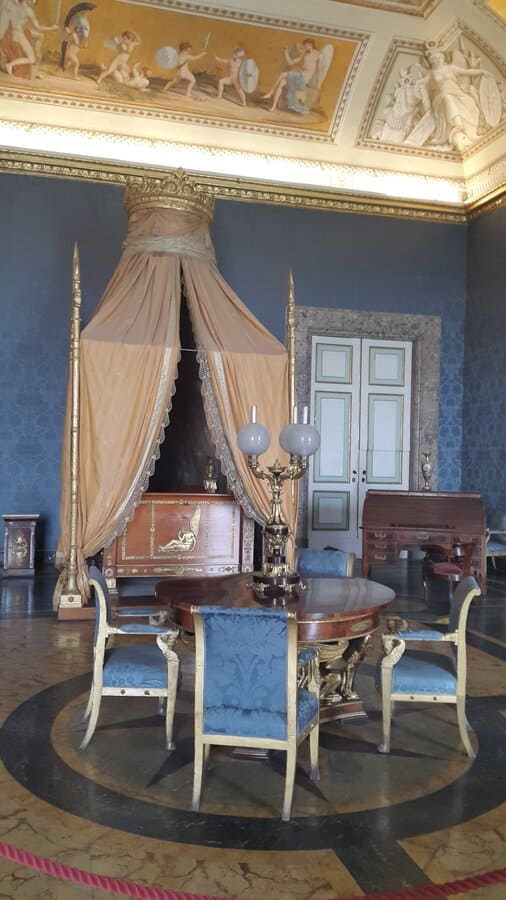
Ferdinand IV and Murat (1780-1815)
The Palace of Caserta became one of the main royal residences of Ferdinand IV, and his wife María Carolina was in charge of decorating the palace, as she had an exquisite taste that she had already demonstrated on several occasions, bringing together an important art gallery and a large porcelain collection.19 The decoration tasks of the royal rooms would not be finished until 1784.2021
With the proclamation of the Parthenopean Republic in 1799 and the flight of the royal family to Palermo, the Caserta palace was confiscated and, although it did not suffer major damage, it was looted and part of the furniture disappeared, although the most important pieces had been put into good repair. I collect. In 1806, again, Naples was invaded by the French army, the kings went into exile in Palermo and Napoleon awarded the Neapolitan crown to his brother Joseph. With the conquest of Spain in 1808, José was sent to rule there and his brother-in-law Murat became the new monarch.
The Mars Room
As early as 1807, José Bonaparte designed new neoclassical decorations of a laudatory nature. However, these were not started until 1809, already reigning Joachim Murat. They were the rooms of the King’s Room designed by Vanvitelli, the current Appartamento Nuovo or dell’Ottocento. His son Carlo had already decorated the first three under the Bourbons, now the decoration of the next three (the Mars Room, the Astrea Room and the Throne Room) was projected.
The monumental halls with pilasters and covered in stucco imitating marble were designed by the architect Antonio De Simone, until in 1811 it was removed and replaced by the decorator Étienne-Chérubin Leconte and the architect Antonio Niccolini. The works remained incomplete after the fall of Murat in 1815 and, shortly after, were purged of any Napoleonic reference.
The Bourbons and the Savoys (1815-1919)
After the Congress of Vienna in 1815, the Bourbon monarchy was restored to the Neapolitan throne and, a year later, the new Kingdom of the Two Sicilies was founded, making Ferdinand IV of Naples Ferdinand I of the Two Sicilies. Henceforth, contrary to popular belief, the palace did not serve as a summer residence, but rather during winter stays in the months of December and January, as well as for short visits in spring.
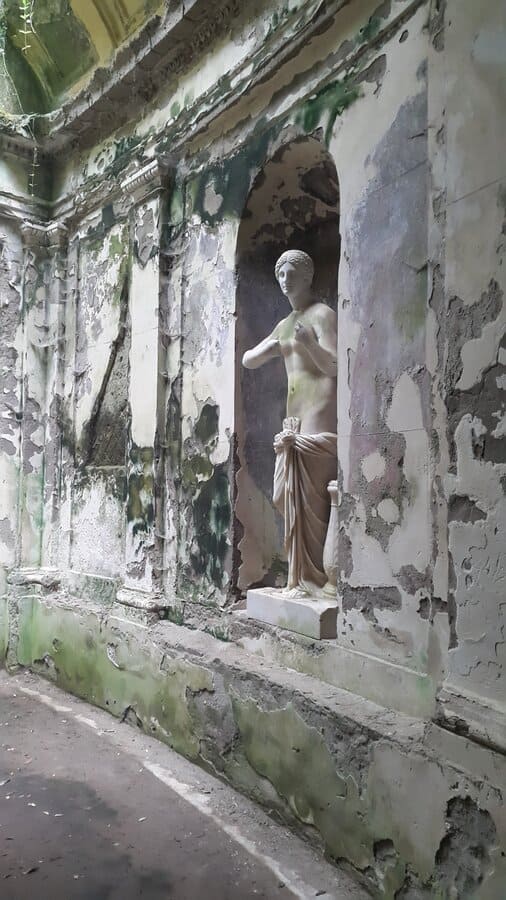
Work continues on the Palace of Caserta
The monarchs continued to embellish their interiors. Under Ferdinand I the plasterwork and bas-reliefs of the Astrea Room were completed in 1822 and the architect Pietro Bianchi began the decoration of the Throne Room in 1823. While Ferdinand II completed the Throne Room between 1843 and 1845, the work of the architect Gaetano Genovese who was rebuilding the Royal Palace of Naples. The result was a monumental space that reinterpreted the Muratian rooms but in a neo-baroque and historicist key, as well as the last great work of the palace, which was inaugurated during the Congress of Scientists in 1845.
Works are completed
Between 1846 and 1847, the works of the palace were officially concluded with the realization of several bas-reliefs in the Hall of Alexander the Great, the central room of the south façade. Much of the interior would remain incomplete, especially the Queen’s Room and the Princess Room that Vanvitelli had designed facing the garden.
The royal apartments in the southern half (below) were decorated before the works were definitively closed in 1847.
On May 22, 1859, King Ferdinand II died in the palace of Caserta, after a long trip he had made to Bari in February to receive Princess Maria Sofia of Bavaria, wife of his son Francis. He was the only monarch to die in Caserta. Shortly before, the Second War of Independence had broken out, which would end with the conquest of the Kingdom of the Two Sicilies by the Garibaldi and Piedmontese troops and the overthrow of Francis II.
The Kingdom of Italy is created
In 1860, with the creation of the Kingdom of Italy, the palace became the property of the House of Savoy and was not alienated like other Bourbon palaces. But starting in 1866, it did begin to receive large history paintings and period furniture by Murat from the Royal Palace of Portici, which was being dismantled.
Since at least 1869, the palace was regularly open to visitors from 9 a.m. to 4 p.m. Admission cost 1 lira and had to be purchased at the royal intendant’s office at the Royal Palace in Naples. In 1888, under the reign of Umberto I, parts of the palace were given over to the Scuola Sottufficiali dell’Esercito (Army NCO School), which in 1896 became the Guardia di Finanza academy.
The royal palace of Caserta was donated to the Italian State by King Victor Emmanuel III in 1919, together with other former Bourbon royal residences such as the Royal Palace of Naples, Capodimonte, Carditello or the Fusaro Casino.
Caserta owned by the Italian State (since 1919)
The royal apartments of the palace were opened as a museum in 1919, while the rest of the rooms housed official bodies. However, Mussolini ceded the entire building as the headquarters of the Military Aeronautics Academy that was installed there between 1926 and 1943.
On December 14, 1943, after the Allied invasion of Italy during World War II, it became the Allied headquarters on the peninsula. The unconditional surrender of German troops from Italy was signed within its walls (April 27, 1945), but the palace had suffered extensive damage during the conflict.
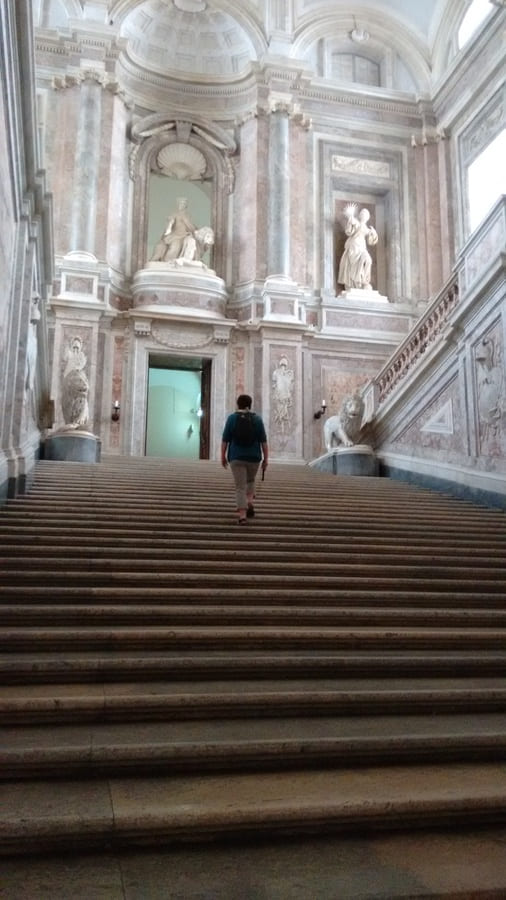
The Palace of Caserta at the End of WWII
After the end of the war, extensive restoration work began on the palace and the garden, which was particularly damaged. The boxwood drawings and the design of some fountains had to be recovered from the original plans that Vanvitelli designed. The most important pieces of furniture, the library and the art gallery had been transferred to other palaces, so it was redecorated following documents and paintings that described the rooms.
The works finished around 1958 and a museum was opened, encompassing the royal apartments, the court theater and the gardens. The rest of the space was allocated to various municipal associations: The Storia Patria Society, the Caserta Cultural Heritage Intendancy, the Regional Tourism Office and the Higher School of Tourism.
In 1994 the president of the Italian Republic, Oscar Luigi Scalfaro, offered a dinner to the heads of state of the G7. Three years later, it was declared a World Heritage Site by UNESCO together with the gardens, the Carolino Aqueduct and the complex architecture of San Leucio.
The structure of the Royal Palace of Caserta
The palatine complex has 1,200 rooms, 1,742 windows, 34 staircases and 1,026 chimneys, occupies an area of around 47,000 square meters, having two equal main facades: one on the parade ground and the other on the park. However, the building differs in some aspects from the initial project, since the central dome and the corner towers were not built. In addition, instead of the facades being crowned by a balustrade, a long row of allegorical statues alluding to the king’s virtues had been planned.7
The structure of the palace strictly follows the plans of Vanvitelli, a rectangular area with two bodies whose intersection in the form of a cross gives rise to four interior patios. The placement of the windows and columns is very precise, giving the scenographic sensation so characteristic of the Vanvitelian style,36 to whose homogeneity the central porticoes and those located at the ends contribute.
Hallways and stairs
Four galleries start from the center of the building, surrounded by the four patios, and the lobby occupies both floors. Both are octagonal-shaped pieces that perfectly represent the balanced Baroque that prevails in the palace, very close to Neoclassicism. The lower hall consists of eight Doric columns that divide the room into eight niches in which Roman sculptures from the Farnese collection were placed, such as the famous Hercules
To the right of the vestibule, so as not to hinder the perspective of the park, is the main staircase that starts in a single section and divides into two when reaching the first landing, allowing the entire architectural structure of the vestibules to be contemplated. Its 117 steps and other decorative elements (balustrade, friezes…) are carved in marble of various shades.
The upper hall reproduces the proportions and layout of the lower one, although it is endowed with greater grandeur thanks to its larger size and the great Palladian-style vault that covers it.38 The harmony and balance that Vanvitelli achieved between the Baroque and Classicism, avoiding the overloaded sumptuousness of the first and the repetition of schemes of the second.
Palatine Chapel of the Palace of Caserta
The chapel occupies one of the four wings of the palace that start from the upper vestibule, with a structure very similar to that of the Palace of Versailles, since it had to be adapted to the demands of court ceremonial.39 It has the same shape as a gallery, topped by a semicircular apse and flanked by a marble colonnade.
It is consecrated to the Immaculate Conception as represented by the only painting that adorns the simple altar, the work of Francesco Solimena, and was inaugurated at midnight mass in 1784, in the presence of the king and the entire court.
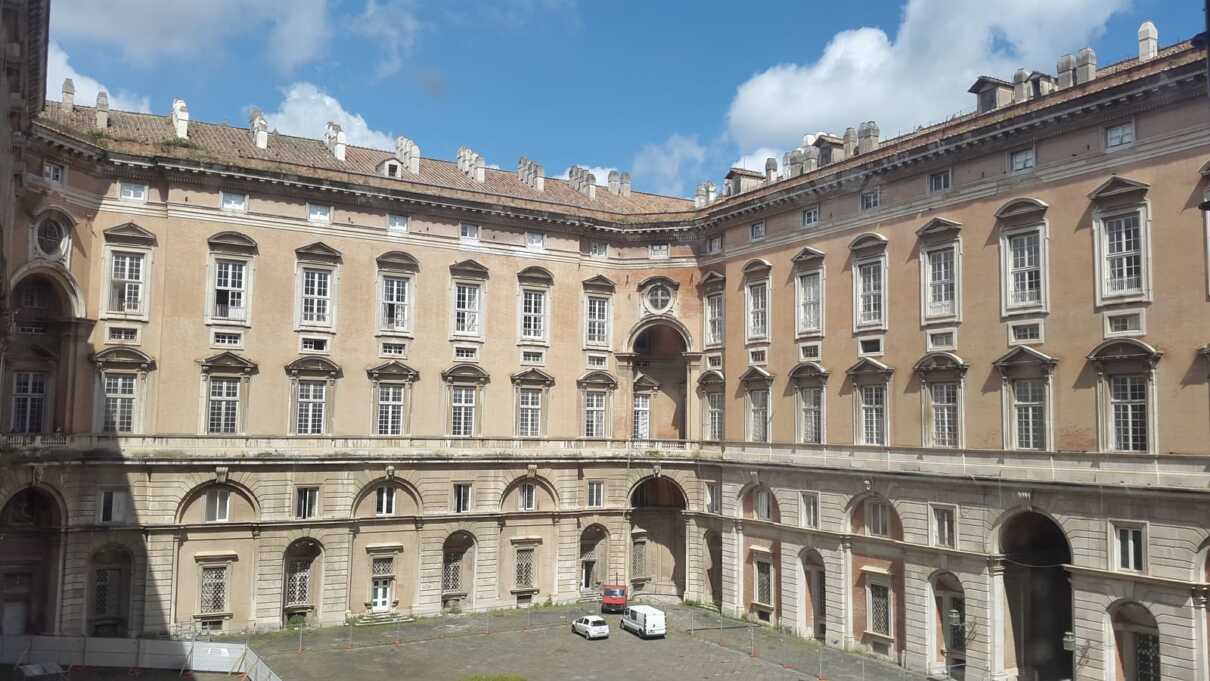
Royal apartments
The Autumn Room is one of the best examples of rococo decoration within the palace. the walls are upholstered with different silks and on the ceiling there are typical eighteenth-century frescoes painted, the Murano lamp and the Meissen vase show the exquisite taste of the queen.
The royal apartments were the rooms intended for the Royal Family and occupied the southern half of the piano nobile of the palace, the other half of the palace was never completed. These rooms stand out above all for their decoration and furniture, which remains the same as when they were inhabited by the sovereigns. In most of the rooms the empire style predominates, but some rooms have maintained a typically rococo look.
The royal apartments can be divided into three areas: the guard rooms, the Appartamento vecchio and the Appartamento nuovo.
Guard rooms
Located after the central hall, the Alaberderos, Guardias de Corps and Alejandro rooms stand out for their large size and rectangular proportions. Its walls are covered with decorative panels of various minerals, moldings bathed in gold leaf and are decorated with scant furniture and paintings, which increases its imposing dimensions.
Apartment Old or Settecento
The set of rococo rooms was the first appartement inhabited by King Fernando de Borbón and his wife María Carolina, originally it was intended for the crown prince. The rooms are characterized by their small size, their frescoed vaults and the abundance of paintings, mirrors and boiseries that cover its walls, creating an atmosphere very different from the rest of the palace. In addition, it contains an important collection of eighteenth-century porcelain gathered by Queen María Carolina. The Spring, Autumn, Winter and Summer rooms, the King’s office and bedroom, where Ferdinand II died, and the Queen’s apartment, with its boudoir and bathroom, are the most common examples. remarkable.
The Palatine library, which can be included in said room, is made up of two reading rooms and three libraries that guard an important archive referring to the Kingdom of the Two Sicilies. Apart from its collections, it stands out for the beauty of the furniture that keeps it48 and a huge Neapolitan crib that is very similar to the one that is preserved in the Royal Palace of Madrid.
Appartamento Nuovo or dell’Ottocento
These rooms were not completed until the first half of the 19th century. The Mars Room and the Astrea Room stand out for their imposing neoclassical architecture and for the profusion of minerals with which they are decorated. However, the most beautiful and remarkable room of this group is the Throne Room, a room inaugurated in 1845, which perfectly represents the prototype of the royal palace of the time. This room had to display all the splendor and wealth of the House of Bourbon, as reflected in its profuse golden stucco, its marble and its abundant moldings: elements that represent the arms of the Kingdom of Naples and the virtues of the monarch or portray the most outstanding kings .
Following the decorative style of the previous rooms, a series of rooms continue to house the Royal Family. Although they were designed in the time of Murat, they were only completed during the brief reign of Francis II, who was the only one to inhabit them. Due to their function, they are smaller in size and the moldings and decorative panels are replaced by Pompeian-style frescoes. They are furnished in the Empire style, in a less light manner than the Appartamento Vecchio. These rooms include the Council Hall, Francis II’s bedroom and bathroom, and Murat’s office and bedroom, so named because they house furniture. of said sovereign.
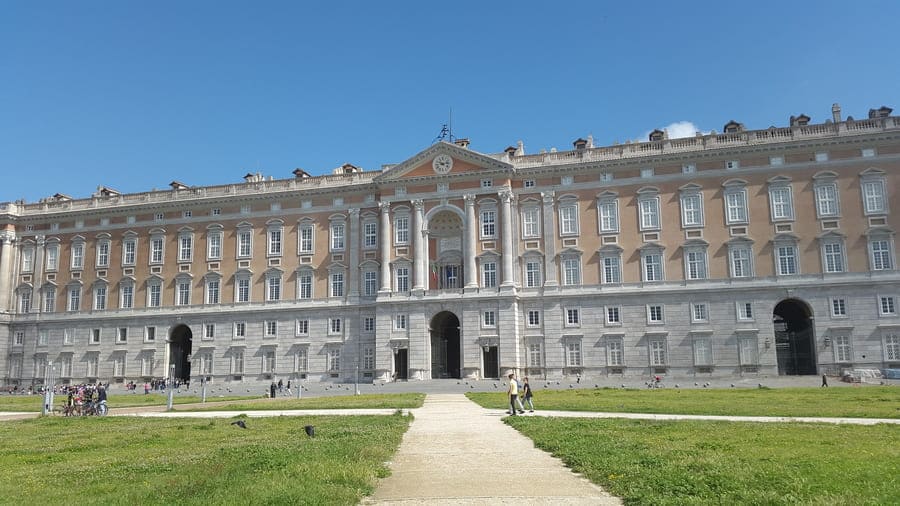
Court theater
The palace theater was also designed by Vanvitelli and bears enormous similarities to the San Carlos Theater in Naples, but its small size gives it a remarkable harmony. It consists of five loggias of boxes, a royal box and an audience; that welcomed during the performances the highest nobles, the royal family and the lower-ranking courtiers respectively.
Its interior is decorated with blue damask and simple golden structures, a far cry from the sumptuous European theaters that use red velvet and profuse gold-plated structures.54 The stage is very small, but in its time it had the most advanced technology, since its rear part could be opened to the park creating a natural background. The first performance was Monteverdi’s opera L’incoronazione di Poppea, on May 5, 1769, but the theater was practically inactive after the reign of Ferdinand IV.
The parks of the Palace of Caserta
The park of the Royal Palace of Caserta is one of the most beautiful royal gardens in Europe, rivaling those of Versailles, Aranjuez or Peterhof. It not only stands out for its landscape design, made by Vanvitelli himself, nor for the quality of its sculptures ; but for being the perfect setting for the Royal Site. The building is enlarged, it is imposing and its architectural domain expands over a much larger space thanks to this decoration.
Vanvitelli’s original design (today modified in the frontal area of the palace) was conceived as a “huge line of flight that, arriving by the royal road from Naples, crossed the palace itself and was lost in the horizon!”. The railway tracks have ruined the scenographic effect on the main façade, since they cut perpendicularly the old road and prevent any perspective. However, on the rear façade the park remains intact: meadows, artificial lakes, roundabouts with statues and rows of trees that flank the very long pond that serves as the axis of the complex
Vanvitelli decided to introduce two types of garden in the park of the palace: an Italian one that surrounded the building and a monumental walkway with numerous fountains, following the French model. To take advantage of the water from the mountains, a row of fountains was designed on its slopes. to reach the palace, reserving the rest of the space for the boxwood garden.
Italian garden
The Italian garden occupies the space immediately behind the palace. This fragment of the park has a landscape design very similar to that of the Boboli Gardens in Florence, with a geometric structure based on paths and boxwood drawings. The botanical species are typical of the native flora of southern Italy, which due to the neglect they suffered in the last century, increased their thickness, making part of the original design disappear.
In this area, also known as the old forest, there are many small recreational buildings, such as pavilions or casini, which were used to liven up the days that the court spent in the garden. It also has a large pond in which fish were raised to supply the palace. Despite the beautiful architecture of these buildings and the age of their trees, it is the least valued part of the park.
Passeggio
The passeggio62 perfectly represents the monumental landscape style of the 18th century, and highlights the scenographic function of the park. A path of more than 2 miles in length that runs along the slope of one of the surrounding mountains, taking advantage of its slope to create a complicated set of fountains and waterfalls. Here Vanvitelli had to put his engineering facet into practice, although he had the help of the experienced Francesco Collicini.
Very close to the top of the mountain, the water brought by the Carolino Aqueduct begins its descent through the large waterfall64 whose pronounced verticality makes it reach a great speed that will allow it to continue its journey. From here on, many fountains follow one another with large sculptural groups and vertiginous water features. Among them stand out:
- The dolphin fountain
- The fountain of Venus and Adonis
- The fountain of Aeolus
- Ceres fountain
- The fountain of Diana and Actaeon
The back façade of the palace faces the passeggio, so that most of the rooms had a view of this beautiful descending succession of fountains. The torrent of water reaches the Italian garden with much less speed, but it serves to feed its many fountains. Vanvitelli’s genius is especially present in this work, in perfect harmony with the building. However, it was his son Carlo who was in charge of executing the plans and numerous sculptors participated, such as Porzio Lionardi, Gaetano Salomone and Paolo Persico.
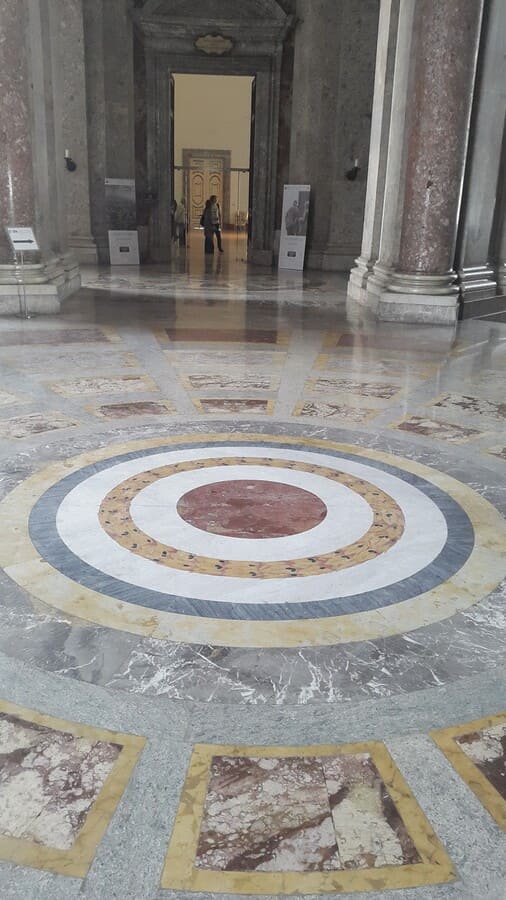
Caserta Royal Palace, English garden
The English-style garden temple was built using remains found in the Pompeii excavations, which blend perfectly into their natural surroundings. Queen Maria Carolina implanted a taste for nature at court, as her sister had done Marie Antoinette at Versailles.
This garden was not designed by Vanvitelli, as Queen Maria Carolina commissioned it shortly after the architect’s death. Again, his son Carlo was in charge of the project, assisted by the English botanist John Graefer, a pupil of Sir Joseph Banks.67 Located in the eastern part of the park, it brings together in its 250,000 square meters a great variety of exotic species that, without However, they acclimatized very well to the mild Neapolitan weather conditions.
In a completely different style from the rest, the English garden fits perfectly into the park as a whole. There are several artificial lakes, a creek and the plans
These grow in apparent freedom intermingled with statues, creating an evocative effect very much in the romantic taste. Here the aim is not to create a beautiful setting with plants and fountains, but to get as close as possible to a natural state, like a forest in which pavilions and statues are hidden.
Stage for the cinema
The Palace of Caserta has become increasingly popular as the setting for Hollywood movie blockbusters, by offering facilities for such filming in the face of the refusal of other illustrious buildings in Italy, such as the Vatican Museums, which are more reluctant to these filming for reasons of security.
Numerous scenes from George Lucas’ films The Phantom Menace and Attack of the Clones were filmed at the palace. In the movies it is identified with the Royal Palace of Theed, capital of Naboo, where Queen Amidala resides and much of the plot takes place.
J. J. Abrams chose this monument to appear in his film Mission: Impossible 3, pretending to be the Vatican City. It was not only shot in interior rooms but also in the courtyards, as in the scene where the Lamborghini explodes.
The similarity with the Vatican was exploited again when Caserta was used as a film set for the films The Da Vinci Code and Angels and Demons.
related Links













